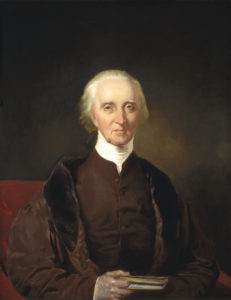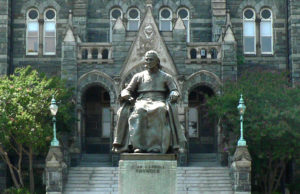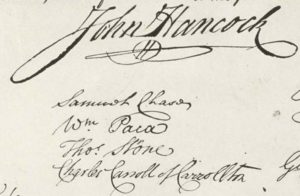Meet the only Roman Catholic to sign the Declaration of Independence
Charles Carroll of Carrollton, the 'First Citizen'

For Americans, the signing of the Declaration of Independence is one of the best-known events in the history of our country. Various signers have gone on to become national heroes and champions of democracy worldwide, such as Thomas Jefferson, Samuel Adams, John Adams, Benjamin Franklin, and John Hancock. These men, however, are just the most well-known signers.
There are 55 other men who added their names to the document that would declare the 13 British colonies independent from Great Britain and change the course of world history. One man, Charles Carroll of Carrollton, is of interest to Catholics, for this wealthy Maryland planter was the only Roman Catholic to have signed the Declaration of Independence. It was an enormous achievement in a period where anti-Catholic sentiment was common among the American colonists.
Charles Carroll of Carrollton was born on Sept. 19, 1737, to the wealthy Carroll family of Irish origin. At a young age, Carroll was sent abroad to study in France, where he received a classical Jesuit education and then studied law in London.
After his studies, which lasted a total of 17 years, he returned to his native Maryland, fluent in five languages. His European Catholic education proved fundamental in his adoption of Enlightenment ideals which would later bring Carroll to openly support the independence of Maryland from Britain. Indeed, it was from reading the works of Montesquieu and Voltaire that Carroll found a passion for republican principles.
Because he was a Catholic, Carroll was not allowed to vote nor was he allowed to hold office. He primarily lived the life of the southern gentry of his plantation, where he gained an enormous amount of wealth and expanded his land. Much of his vast estate still exists today, such as Doughoregan Manor, Hockley Forge and Mill and Homewood Manor, which is now part of the Johns Hopkins University campus. Much of Carroll’s estate was manned by slaves, of which he owned over 300. While Carroll was opposed to slavery on moral and religious grounds and proposed the gradual abolition of the practice as well as the humane treatment of slaves, he never freed his own slaves during his lifetime.
While Carroll was prohibited from participating in politics because of his religion, the colonies’ tension with Britain increasingly made this impossible. He was critical of the Stamp Act, believing it violated English law, and thus was an early proponent of “No taxation without representation.” Because of this, Carroll believed that the English constitution would be dissolved, and thus America would be the only place where the liberties that certain Englishmen enjoyed would be allowed to continue.
When the royal governor of Maryland decreed fees for the citizens of the colony, Carroll took his position public. He debated the issue of independence under the pseudonym “First Citizen” in the Maryland Gazettewith the British loyalist and Maryland Attorney General Daniel Dulaney, himself using the pseudonym “Antillon.”
Eventually, the identity of the two men was discovered and Carroll became somewhat of a celebrity in the colony, especially after Dulaney resorted to using personal attacks against Carroll’s religion in the debates.
With his new found fame, Carroll became the leading voice in Maryland for independence, engaging in action against the mother country. He attended the First Continental Congress and supported the colony’s boycott of British tea. He also negotiated the burning of a British ship that was importing tea in the Annapolis harbor, the Peggy Stewart. Carroll believed that the burning of the ship would quell an angry mob who opposed the Tea Act while simultaneously sparing the lives of the ship’s loyalist captain and his 53 indentured servants.

In February 1776, Carroll was sent on a diplomatic mission to Canada in order to convince the French Canadians, who had been under British control for a decade, to join the American cause and fight against Britain. Accompanying him were Benjamin Franklin, Samuel Chase, and Charles’ cousin John, who would later become the first bishop and archbishop of the United States.
Carroll was considered ideal for the mission, as he spoke fluent French because of his education in France. His Catholicism was also thought to appeal to the French-speaking populace, themselves majority Catholic. Despite his suitability for the role, Carroll’s mission ultimately failed, partially due to the fact that Britain had granted the French Canadians religious rights while the rebellious colonies were considered virulently anti-Catholic.

Despite this failure, Carroll’s place in history would be cemented on July 4, 1776, when he was sent to the Second Continental Congress representing Maryland. Although he arrived late and thus was not able to vote in favor for the Declaration of Independence, he was able to sign the copy that exists today. Here, he signed his name as Charles Carroll of Carrollton in order to distinguish himself from the various other Charles Carrolls that lived in Maryland at the time, all of whom were his relatives. Thus, Charles Carroll became the only Roman Catholic to sign the Declaration of Independence.
After the signing, Carroll remained active in politics. He helped create the Maryland Constitution and Declaration of Rights, and then introduced the Electoral College, which would later be introduced on a federal level. Because of his participation, Maryland later lifted the ban on Catholics holding public office. This meant that Catholics from Maryland were some of the most vocal supporters for independence from Great Britain. Now allowed to hold public office, Carroll served in the Continental Congress from 1776–78 and, after independence was achieved, in the Maryland state Senate.
Carroll left public life in 1801 after Thomas Jefferson’s election as president in 1800, and focused mainly on his land and family life. He would only come out of retirement to work on construction projects, such as the Baltimore and Ohio Railroad, of which he laid the first stone on July 4, 1828.

At the time, he was the last remaining signatory of the Declaration of Independence, as both Jefferson and John Adams had died on July 4, 1826. Charles Carroll of Carrollton would later die at his daughter’s house in Baltimore in 1832, at the age of 95. With his death, all the signatories had passed into history.
Today, Charles Carroll is honored throughout the United States as a founding father, an intellectual, and a patriot. There are various counties, towns, neighborhoods, and institutes of higher education that bear his name. He should also be remembered, however, for breaking down barriers for Catholics and other religious minorities in the United States in a period where they were regarded with great suspicion.
While it would take almost another two centuries before Catholics would truly be integrated into American society, the fact that a Catholic had signed the Declaration of Independence and then held office in the newly established country would indeed serve as a stepping stone and pave the way for the likes of prominent Catholics to run for office, such as Al Smith and John F. Kennedy. In this way, Charles Carroll truly was a founding father, a “First Citizen.”
Work Cited
McClanahan, Brion. “Charles Carroll of Carrollton: The Southern Irish Catholic Planter.” Abbeville Institute, March 17, 2016, www.abbevilleinstitute.org/review/charles-carroll-of-carrollton-the-southern-irish-catholic-planter/.

